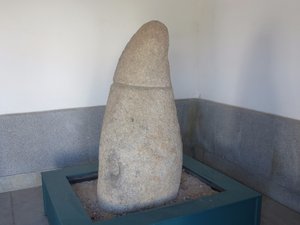Advertisement
Published: October 12th 2017

 A dolmen from the Evora area
A dolmen from the Evora area
The construction of these structures date back to the 6th millennium BC. They were rediscovered in 1966 by Henrique Leonor Pina, who was proceeding with field work relating to the country's geological charts.We changed plans yesterday, and decided to make Evora a day trip rather than a place to spend the night later in our trip. So, today we took a bus to the historic city, and spent the afternoon wandering its streets. The area has been inhabited since before 4000 BC, and important city for many cultures: Neolithic, Roman, Muslim, and Portuguese. Three rivers come together near here, and it is thought that is why this area had such importance early on.
Romans were here from the second century BC to the fourth century AD. The Moors took over from the eighth to the twelfth century.
Évora was
reconquered from
Arab hands in 1166 by
Geraldo Sem Pavor (Gerald the Fearless), and soon afterwards the new Christian rulers of the city began to build a
cathedral, dedicated to the
Virgin Mary. This first building, built between 1184 and 1204, was very modest and was enlarged circa 1280-1340, this time in early
Gothic style. The cathedral received several valuable additions through time, such as the Gothic
cloisters (14th century), the
Manueline chapel of the Esporão (early 16th century) and a new, magnificent main chapel in
baroque style (first half of the 18th century). It is

 Crowds suddenly appear!
Crowds suddenly appear!
We were the only tourists on the bus from Lisboa, but as soon as we got inside the walls of Evora, crowds appeared!the largest of the medieval cathedrals in Portugal, and one of its best examples of
Gothic architecture.
The bus ride took us across the river from Lisboa on the Ponte Vasco da Gama Lisbon. It is a massive 17km long bridge that spans the shallow but wide Tagus estuary to the east of Lisbon. It was once Europe's longest bridge and was named after Portugal's great explorer Vasco da Gama. We continued though the countryside, where much of the area has sandy soil and is quite dry. There are acres and acres of olive or cork groves in between small towns. After about an hour and a half on the bus ( a pricey ride at $30 round trip each, but a very comfortable bus..) we arrived in Evora. Unfortunately, the Roman Temple and another church were both covered with screening and under repair.
We visited the main Cathedral, the Se, and paid to go up on the roof. An interesting a bit of history that we learned here:
The Tenshō Embassy to Europe (1582~1586) One of the most remarkable events in the history between the two countries is surely the delegation of "Tenshō Mission" from Japan to
Europe. In 1549, Jesuit missionaries, including St. Francis Xavier arrived in Kagoshima, southern Japan, and started the first mission of evangelization in Japan. The mission was composed of four young Japanese missionaries, amongst which Mancio Itō (the spokesman) Miguel Chijiwa (千々石 ミゲル), Julião Nakaura (中浦 ジュリアン) and Martinho Hara (原 マルチノ). All of them had only between thirteen and fourteen years old.The four young men and their tutor and interpreter Diego de Mesquita left the city of Nagasaki on the 20th February 1582 and, passing through Macau and Goa, arrived at Lisbon in August 1584. In Portugal, They were visiting the Church of San Roque, Jerónimos Monastery and also other places like Sintra and Évora. From Portugal, the delegation of Japanese missionaries went to Rome where they finally had an audience with Pope Gregory XIII.
After viewing the interior, we walked to the shrouded temple, and then spent a delightful hour in the Evora Museum. The history of Evora’s museum goes back to 1804 when Friar Manuel Cenáculo, Archbishop of Évora,
inaugurated a public library which also comprised part of his art, archaeological and natural collections. The present museum was created in 1915 when the museum started exhibiting workpieces from
Evora Public Library director, Dr. Augusto Filipe Simões, who (during the 1870s) also collected Roman, Visigothic and Arab pieces which were part of
D. Manuel Palace, the Roman Temple and
Giraldo Square.
The collection is small, but striking and informative.
After wandering the backstreets in the heat but away from the crowds, we found a student cafe tucked away inside a walled courtyard with old trees and lots of shade. Lunch was about $6.00/person, and beers were only a $1.00!..
We walked back to the station, and gratefully got into the air-conditioned bus, where we both fell asleep for awhile! Getting old, I guess...
On the way back to Lisboa, we crossed the 25 de Abril Bridge connecting the city of
Lisbon to the municipality of
Almada on the left (south) bank of the
Tagus river. It was inaugurated on August 6, 1966, and a train platform was added in 1999. Because it is a suspension bridge and has similar coloring, it is often compared to the
Golden Gate Bridge in San Francisco, US. It
was built by the
American Bridge Company which constructed the
San Francisco–Oakland Bay Bridge, but not the Golden Gate.
We packed tonight, and will say goodbye to this wonderful apartment in the morning, when we take a bus south to the coast, and stay in the town of Sagres for three nights.
.
Advertisement
Tot: 0.097s; Tpl: 0.012s; cc: 9; qc: 23; dbt: 0.0509s; 1; m:domysql w:travelblog (10.17.0.13); sld: 2;
; mem: 1.1mb























